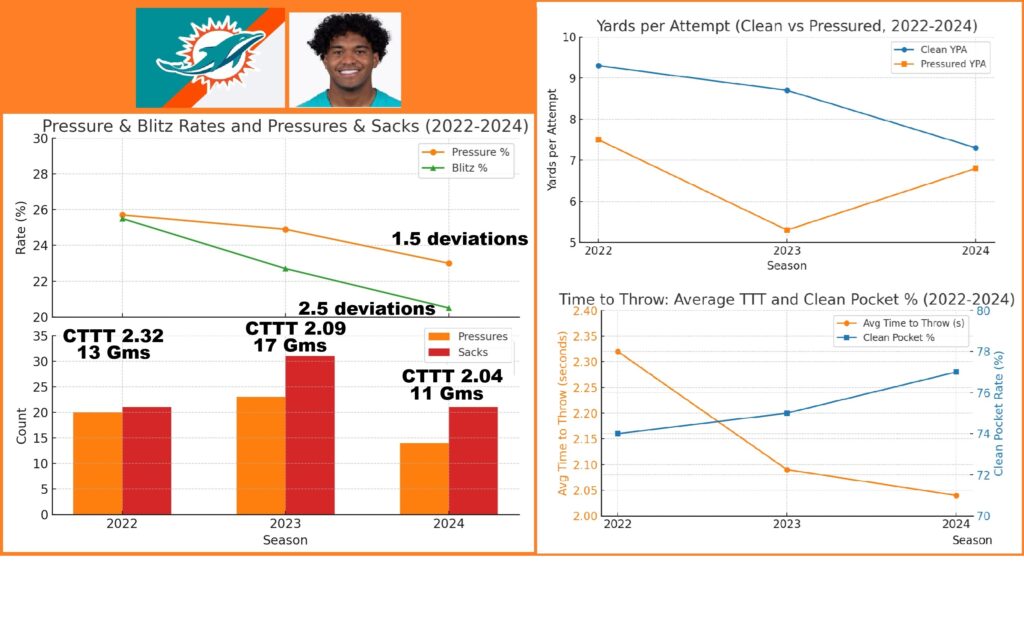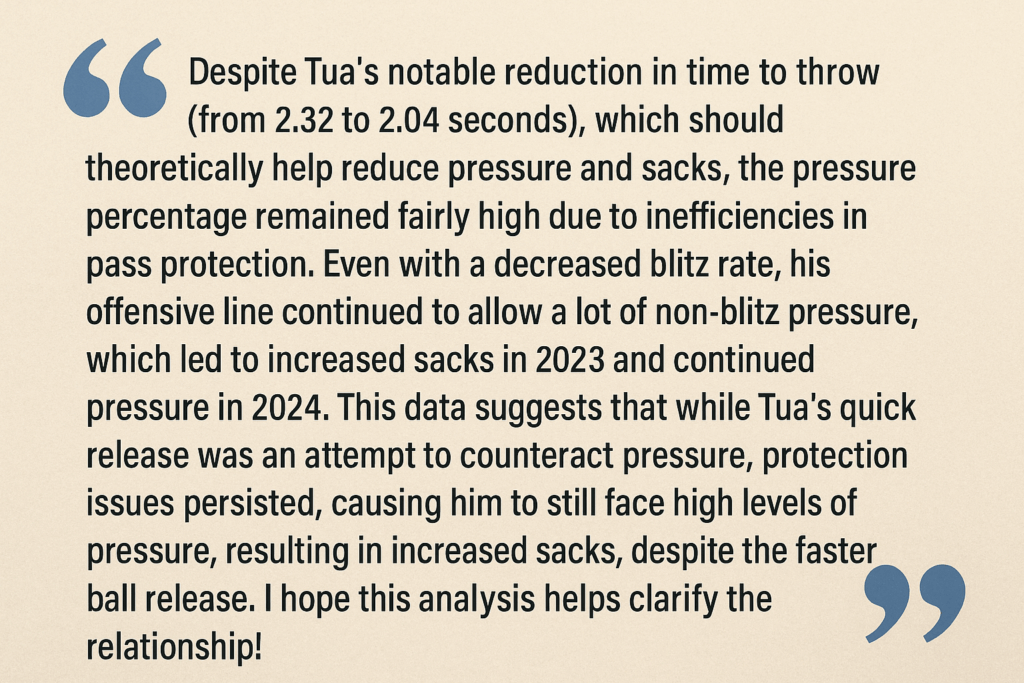AI Evals Years of Data on Tua & Oline vs the “D”s!
Fandom is full of passion, here’s the purely analytical take from AI
Artificial Intelligence isn’t going anywhere, so I decided to take a host of data feed it to Chat GPT and see if its evaluation matched mine. I created a basket of analytics over the 2022-2023 seasons for it to dissect and create graphic to show them and give an evaluation based on the date. AI made its evaluation using clean time to throw, clean and pressured %, yards per attempt, pressure % and pressures, sacks, blitz rate, depth of target.
This is a strong data set to make the call.
This evaluation isn’t to say Tua is great or not, but rather to show the relationship between Tua and his protection. Also, it will show how the defenses they face reacted philosophically to the philosophies of Mike McDaniel and whether he had a conducive or non-conducive environment to throw in.
So, here’s the breakdown, graphics and the AI’s evaluation of the data.
The Speed of the Throw
In recent seasons, one of the most talked-about aspects of Tua Tagovailoa’s game has been his ability to get the ball out quickly. In the 2022-2024 period, his Time to Throw (TTT) steadily decreased, from 2.32 seconds in 2022 to an impressive 2.04 seconds in 2024, making him one of the fastest quarterbacks in the NFL. On paper, this should help minimize pressure and reduce sacks. But, despite these impressive improvements, the reality on the field tells a more complex story.
You can bet with the best pay per head that Tua’s decreased release time was an effort to beat the defense before it could collapse the pocket. In 2023, his TTT dropped to 2.09 seconds and then reached 2.04 seconds in 2024. These figures far outpace the league average, showing a clear trend of quick decisions and even quicker throws. But this rapid release didn’t come without challenges.
Here’s the graphic full of analytics this article was based off:
Pressure and Sacks: Still a Reality
The relationship between Tua’s quick release and the pressure he faces on each play isn’t as straightforward as one might think. Despite the reduced time to throw, Tua’s Pressure Percentage remained stubbornly high. In 2022, he faced pressure 25.7% of the time, which dropped slightly to 24.9% in 2023, and then to 23% in 2024. While the pressure rate went down, it didn’t decline at the same pace as his release time. That means the protection issues in the pocket remained a major factor.
More strikingly, sacks became a problem that Tua couldn’t outrun. In 2023, he was sacked 31 times, a jump from the 21 sacks he endured in 2022. By 2024, the sack total dropped back to 21, but the fact remains—despite getting the ball out faster, the offensive line continued to struggle with non-blitz pressures. While the blitz rate dropped significantly (from 25.5% in 2022 to 20.5% in 2024), the protection issues on non-blitz plays led to more frequent sacks in 2023.
A Growing Trend: Less Blitzing, More Pressure
In an interesting twist, teams were blitzing less often, but that didn’t prevent the pressure. The Blitz Rate decreased each year from 25.5% in 2022 to 22.7% in 2023 and finally 20.5% in 2024. But even with fewer blitzes, defenses were still able to generate pressure, which suggests that the quick release alone wasn’t enough to neutralize the impact of a struggling offensive line.
Conclusion
With the hopeful improvement of the offensive line, this season could determine whether Tua’s speed on release is the answer or just another part of the puzzle that still needs solving. We’ll see soon enough! The biggest part of the puzzle will be can he stay healthy. We’ll see soon enough on that as well! How does he AI’s eval match up with yours? Go Phins!!!
This article was written in collaboration with ChatGPT, who helped analyze Tua’s performance data, shedding light on the nuanced relationship between quicker release times and ongoing pass protection issues. A special thanks to ChatGPT for its valuable insights!
















Great article! But any fan could review the outcome and produce the same conclusion. Tua worked on his performance, became a somewhat better QB, but was hindered by a mediocre O-line. Tua reduced his lapses in judgement and got rid of the ball quicker, but was still pulverized by the defense, thus Tua became injury prone. No need for graphs. The o-line suffers from injuries that force the Dolphins to continually mix and match players. The bench is thin.
Thanks Van!Oline makes the NFL world go around… for some reason Grier didn’t know that… This OL has some potential, but as you said it’s thin… I did this to offer as much info as possible to help those who didn’t see it and cement the eval of those who did. Let’s hope things change… fingers crossed.